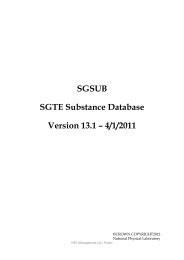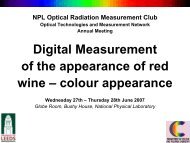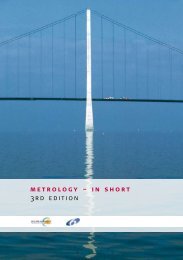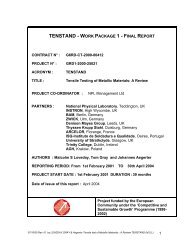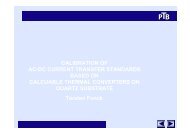A corrosion protection guide For steelwork exposed to atmospheric ...
A corrosion protection guide For steelwork exposed to atmospheric ...
A corrosion protection guide For steelwork exposed to atmospheric ...
Create successful ePaper yourself
Turn your PDF publications into a flip-book with our unique Google optimized e-Paper software.
Corus Construction & Industrial<br />
A <strong>corrosion</strong> <strong>protection</strong> <strong>guide</strong><br />
<strong>For</strong> <strong>steelwork</strong> <strong>exposed</strong> <strong>to</strong> <strong>atmospheric</strong> environments
<strong>For</strong> <strong>steelwork</strong> <strong>exposed</strong> <strong>to</strong> <strong>atmospheric</strong> environments<br />
Surface <strong>protection</strong> <strong>guide</strong> for <strong>steelwork</strong> <strong>exposed</strong> <strong>to</strong><br />
<strong>atmospheric</strong> environments<br />
Specifiers are advised <strong>to</strong> seek specialist advice for the <strong>protection</strong> of <strong>steelwork</strong> used in road or rail bridges, buried<br />
in the ground or immersed in water.<br />
Notes<br />
Environment<br />
category (a)<br />
a) Environment Categories C3/C4/C5 above are based on those given in BS EN ISO 12944 and ISO 9223.<br />
b) There may be times or locations where the corrosivity category is higher than expected. <strong>For</strong> example, lighting<br />
columns that may be located in environment category C3 may be subjected <strong>to</strong> local conditions that may be<br />
equivalent <strong>to</strong> category C5M when salt is spread on the roads and pavements during winter.<br />
List of standards<br />
Corrosion<br />
risk<br />
BS EN ISO 12944: 1998 Paints and varnishes <strong>corrosion</strong> <strong>protection</strong> of steel structures by protective paint systems.<br />
BS EN ISO 14713: 1999 Protection against <strong>corrosion</strong> of iron and steel in structures – Zinc and aluminium coatings – Guidelines.<br />
BS EN ISO 1461: 1999 Hot dip galvanized coatings on fabricated iron and steel articles – Specifications and test methods.<br />
BS EN 10240: 1998 Coatings for steel tubes: Specification for hot dip galvanized coatings.<br />
ISO 4628-3: 1982 Paints and varnishes – Evaluation of degradation of paint coatings – Designation of intensity, quantity and size<br />
of common types of defect – Part 3: Designation of degree of rusting.<br />
BS 7079: Part A1 Preparation of steel substrates before application of paints and related products – Visual assessment of surface<br />
(ISO 8501-1) cleanliness – Part 1: Rust grades and preparation grades of uncoated steel substrates and of steel substrates<br />
after overall removal of previous coatings.<br />
ISO 9223: 1992 Corrosion of metals and alloys – Corrosivity of atmospheres – Classification.<br />
BS EN 22063: 1994 Metallic and other inorganic coatings – Thermal spraying – Zinc, aluminium and their alloys.<br />
Notes <strong>to</strong> table (overleaf)<br />
Exterior environments<br />
Typical <strong>steelwork</strong> location (b)<br />
C3 Medium Most rural and urban areas with low sulphur dioxide, acid, alkali and salt pollution.<br />
C4 High<br />
C5I<br />
C5<br />
C5M<br />
Very high<br />
Urban and industrial atmospheres with moderate sulphur dioxide pollution and/or<br />
coastal areas with low salinity.<br />
Industrial areas with high humidity and aggressive atmospheres.<br />
Coastal and offshore areas with high salinity.<br />
1. Coating system durability given in the table is based on practical experience. It is the expected life, in years, before first major<br />
maintenance (See MAINTENANCE below). This is taken as degradation level Ri3 from ISO 4628 Part 3 (1% of surface area rusted). It<br />
should be noted that this does not imply a guarantee of life expectancy.<br />
2. The durability of galvanized <strong>steelwork</strong> is derived from the figures in BS EN ISO 14713.<br />
3. Where painting of galvanized <strong>steelwork</strong> is required for aesthetic or other reasons; suitable systems from BS EN ISO 12944 may<br />
be used.<br />
4. The thickness values given for primers are the <strong>to</strong>tal thickness used and may include a pre-fabrication primer. <strong>For</strong> example – 80µm can<br />
be in one coat or as 20µm pre-fabrication primer plus 60µm post-fabrication primer.<br />
5. Costs given here are for guidance only. There will be considerable variation that may typically be +/- 50% for a variety of reasons.<br />
Quotations should be obtained before making the final selection of the protective treatment. The indicative costs given are for 2004.<br />
They include estimates for material and labour but exclude taxes. The average surface area/<strong>to</strong>nne is assumed <strong>to</strong> be 25m 2 /<strong>to</strong>nne.<br />
6. It should be noted that the colour range of micaceous iron oxide (MIO) is limited.<br />
7. In some countries, the use of sprayed zinc or alloys of zinc and aluminium may be preferred (BS EN 22063).<br />
8. The zinc rich primer applied at 80µm would increase the durability of the system by approximately 5 years and increase the cost by<br />
£2.00/m 2 .<br />
9. <strong>For</strong> <strong>steelwork</strong> 6mm thick or greater, the minimum average coating thickness is 85µm.<br />
2 A <strong>corrosion</strong> <strong>protection</strong> <strong>guide</strong>
General notes<br />
This document gives details of <strong>corrosion</strong> <strong>protection</strong><br />
systems for <strong>steelwork</strong> <strong>exposed</strong> <strong>to</strong> <strong>atmospheric</strong><br />
environments.<br />
Design<br />
The rate at which <strong>corrosion</strong> occurs largely depends on<br />
the period of wetness. Steelwork should, wherever<br />
possible, be designed <strong>to</strong> shed rainwater and<br />
condensation. Any details that collect or retain water<br />
should be redesigned or incorporate adequate<br />
drainage. Detailed advice may be obtained from<br />
BS EN ISO 12944 or BS EN ISO 14713.<br />
Coating thickness<br />
The film thicknesses given in the table are nominal dry<br />
film values (µm = micron = 0.001mm). Coating<br />
thicknesses have been chosen in accordance with the<br />
principles of BS EN ISO 12944.<br />
Workmanship<br />
It is assumed that the quality of work and any repairs will<br />
be <strong>to</strong> an acceptable professional standard and in<br />
accordance with the coating manufacturers<br />
recommendations.<br />
Environment<br />
category C3<br />
System number B12 B14 B15<br />
Anticipated durability of<br />
the coating system in<br />
years (notes 1 & 2) for<br />
environment category<br />
Nearest equivalent BS EN ISO 12944<br />
Shop<br />
applied<br />
Site<br />
applied<br />
Surface preparation<br />
(BS 7079: Part A1)<br />
Coatings<br />
(note 4)<br />
Coatings<br />
C3 40 20 20<br />
C4<br />
C5<br />
Approximate cost in £/m 2 (note 5)<br />
30 15 15<br />
15(C5I)/20(C5M) 10 10<br />
Hot dip galvanize <strong>to</strong><br />
BS EN ISO 1461<br />
None<br />
(note 3)<br />
– S1.34 S1.31<br />
– Blast clean <strong>to</strong> Sa 2 1 ⁄2 Blast clean <strong>to</strong> Sa 2 1 ⁄2<br />
85µm<br />
<strong>For</strong> <strong>steelwork</strong> <strong>exposed</strong> <strong>to</strong> <strong>atmospheric</strong> environments<br />
Zinc phosphate epoxy<br />
primer (note 4)<br />
High build epoxy MIO<br />
Recoatable polyurethane<br />
finish<br />
8.00 11.50 8.85<br />
Surface preparation<br />
Correct surface preparation is essential for satisfac<strong>to</strong>ry<br />
performance of coatings. Thorough removal of grease,<br />
dirt, rust and loose paint must be carried out before<br />
application of all coatings.<br />
Coating systems<br />
80µm<br />
100µm<br />
Steelwork fabrica<strong>to</strong>rs’ process routes vary. The<br />
sequence may be a) Blast – Fabricate – Prime or b)<br />
Blast – Prime – Fabricate or c) Fabricate – Blast – Prime.<br />
The choice of sequence depends on the facilities<br />
available <strong>to</strong> the fabrica<strong>to</strong>r or applica<strong>to</strong>r, and the size of<br />
the structural members. A prefabrication primer may or<br />
may not be needed, depending on the sequence<br />
chosen. Under certain circumstances, some of the coats<br />
given in treatments as ‘site-applied’ may be applied in<br />
the shop if preferred. Similarly, some treatments given<br />
as ‘shop-applied’ may be applied on site.<br />
Galvanized components<br />
High solid epoxy zinc<br />
phosphate primer<br />
High solid aliphatic<br />
polyurethane finish<br />
60µm None<br />
The weathering of zinc/iron alloy layers of the<br />
galvanized coating can give the appearance of<br />
superficial rusting many years before the durability limit<br />
has been reached. Where galvanized <strong>steelwork</strong> is<br />
affected by ‘white rust’ (wet s<strong>to</strong>rage stain) this should<br />
be removed with a stiff brush and washed with water<br />
before subsequent pre-treatment and coating.<br />
A <strong>corrosion</strong> <strong>protection</strong> <strong>guide</strong> 3<br />
100µm<br />
100µm
Environment<br />
category C4<br />
E6<br />
25<br />
15-20<br />
12<br />
S1.35<br />
Blast clean <strong>to</strong> Sa 2 1 ⁄2<br />
Zinc rich epoxy primer<br />
High build epoxy MIO<br />
High build epoxy MIO<br />
(note 6)<br />
11.50<br />
40µm<br />
100µm<br />
100µm<br />
Galvanized or sherardized fasteners should be used<br />
with galvanized <strong>steelwork</strong>.<br />
Fire <strong>protection</strong><br />
Corrosion <strong>protection</strong> and fire <strong>protection</strong> are sometimes<br />
required <strong>to</strong>gether. If such an occasion arises, advice<br />
should be sought from the manufacturer of the fire<br />
<strong>protection</strong> system.<br />
Concrete encasement<br />
Structural steel fully encased in concrete is not normally<br />
coated. It is suggested that the provisions of Eurocode 2<br />
and/or Eurocode 4 should be followed. The concrete<br />
should have the correct composition and compaction<br />
with a depth of cover appropriate for the environment.<br />
Further guidance can be found in BS 8110, Part 1. As an<br />
alternative <strong>to</strong> concrete encasement, <strong>steelwork</strong> in<br />
corrosive environments e.g. below ground level, can be<br />
protected by the application of a high build epoxy<br />
coating <strong>to</strong> 450µm after suitable blast cleaning. Where<br />
steel is partially embedded in concrete in environments<br />
C3, C4 and C5, e.g. at column bases, extra <strong>protection</strong><br />
should be provided at the steel/concrete junction by<br />
means of an alkali resistant paint at the junction or an<br />
alkali resistant mastic at the joint.<br />
E8<br />
30+<br />
20-25<br />
15<br />
–<br />
Blast clean <strong>to</strong> Sa 3<br />
Sprayed aluminium <strong>to</strong><br />
BS EN 22063 (note 7).<br />
Zinc phosphate<br />
epoxy sealer coat<br />
High build epoxy MIO<br />
Recoatable polyurethane<br />
finish<br />
30.00<br />
150µm<br />
50µm<br />
100µm<br />
60µm<br />
Environment<br />
category C5<br />
E9<br />
30<br />
25<br />
20<br />
S5.06<br />
Blast clean <strong>to</strong> Sa 2 1 ⁄2<br />
Zinc rich epoxy primer<br />
(note 8)<br />
High build epoxy MIO<br />
(one or two coats)<br />
High solid aliphatic<br />
polyurethane finish<br />
15.00<br />
Environmental issues<br />
The handling and application of all protective coatings<br />
must be carried out in accordance with the<br />
manufacturer's recommendations and comply with the<br />
requirements of relevant environmental legislation.<br />
Handling and transport<br />
Care in handling <strong>to</strong> minimise mechanical damage is<br />
essential <strong>to</strong> the performance of the protective system.<br />
The responsibility for the repair of damaged coatings<br />
should be clearly defined.<br />
Site s<strong>to</strong>rage<br />
Incorrect s<strong>to</strong>rage on site before erection can accelerate<br />
the deterioration of coatings. Steelwork should be<br />
supported off the ground with items separated by<br />
wooden battens allowing free circulation of air. Avoid<br />
‘ponding’ (retention of standing water) by laying down<br />
<strong>steelwork</strong> <strong>to</strong> ensure adequate drainage.<br />
Hollow sections<br />
It is unnecessary <strong>to</strong> coat the interior of sealed<br />
hollow sections.<br />
Maintenance<br />
<strong>For</strong> <strong>steelwork</strong> <strong>exposed</strong> <strong>to</strong> <strong>atmospheric</strong> environments<br />
40µm<br />
200µm<br />
80µm<br />
E11<br />
40+<br />
30+<br />
20+<br />
24.00<br />
The first major maintenance is recommended when the<br />
level of coating degradation reaches Ri3 as illustrated in<br />
ISO 4628 Part 3 (1% of surface area rusted).<br />
–<br />
–<br />
Hot-dip galvanize <strong>to</strong><br />
BS EN ISO 1461 (note 9)<br />
Mordant wash<br />
Epoxy primer<br />
High build epoxy MIO<br />
Recoatable polyurethane<br />
finish<br />
40µm<br />
100µm<br />
60µm<br />
A <strong>corrosion</strong> <strong>protection</strong> <strong>guide</strong> 4
Exterior <strong>steelwork</strong> –<br />
surface <strong>protection</strong><br />
This document is intended <strong>to</strong><br />
provide guidance <strong>to</strong> engineers and<br />
architects concerned with the<br />
design of new structures. Where<br />
possible, the document is in<br />
accordance with existing and<br />
proposed standards and represents<br />
a consensus of the experience of<br />
different European countries.<br />
The document does not seek <strong>to</strong><br />
Some examples of detailing <strong>to</strong> minimise <strong>corrosion</strong><br />
Details should be designed <strong>to</strong> enhance durability by avoiding water entrapment.<br />
Avoid<br />
entrapped<br />
dust and water<br />
Dirt collection Sealing plate<br />
Bad<br />
Other sources of advice<br />
The British Constructional<br />
Steelwork Association Ltd<br />
4 Whitehall Court<br />
Westminster<br />
London SW1A 2ES<br />
T 0207 839 8566<br />
F 0207 976 1634<br />
cover every possible case. The<br />
systems suggested are considered<br />
<strong>to</strong> be reasonable, cost effective<br />
methods of providing <strong>protection</strong> in<br />
normal European environments.<br />
There is no intention <strong>to</strong> restrict the<br />
specifier's field of choice. In some<br />
circumstances other methods of<br />
<strong>protection</strong> not given here may be<br />
economic as well as beneficial. New<br />
coatings are being developed<br />
continuously and the authors wish<br />
Pay particular<br />
attention <strong>to</strong><br />
column bases<br />
Encourage<br />
air movement<br />
Prevention of retention of<br />
water and dirt at junction<br />
plates by means of ‘breaks’<br />
Avoid open<br />
crevices<br />
Paint Research Association<br />
Waldegrave Road<br />
Tedding<strong>to</strong>n<br />
Middlesex TW11 8LD<br />
T 0208 614 4800<br />
F 0208 943 4705<br />
<strong>For</strong> <strong>steelwork</strong> <strong>exposed</strong> <strong>to</strong> <strong>atmospheric</strong> environments<br />
<strong>to</strong> encourage such development.<br />
Environments have been divided<br />
in<strong>to</strong> three categories, but there will<br />
be variations around and within<br />
these categories. <strong>For</strong> this and other<br />
reasons, specifiers must use their<br />
judgement and, where necessary,<br />
take advice in selecting the optimum<br />
system. Any of the contributing<br />
bodies, or the manufacturers of<br />
protective systems, will be pleased<br />
<strong>to</strong> offer advice on systems for<br />
individual projects.<br />
Best<br />
Drainage break<br />
Galvanizers Association<br />
Wren’s Court<br />
56 Vic<strong>to</strong>ria Road<br />
Sut<strong>to</strong>n Coldfield<br />
West Midlands B72 1SY<br />
T 0121 355 8838<br />
F 0121 355 8727<br />
A <strong>corrosion</strong> <strong>protection</strong> <strong>guide</strong> 5
www.corusgroup.com<br />
Care has been taken <strong>to</strong> ensure that this<br />
information is accurate, but Corus Group<br />
plc, including its subsidiaries, does not<br />
accept responsibility or liability for errors or<br />
information which is found <strong>to</strong> be misleading.<br />
Copyright Corus 2004<br />
Designed and produced by<br />
Orchard Corporate Ltd.<br />
Corus Construction & Industrial<br />
Technical Sales and Marketing<br />
PO Box 1<br />
Brigg Road<br />
Scunthorpe<br />
North Lincolnshire<br />
DN16 1BP<br />
T +44 (0) 1724 405060<br />
F +44 (0) 1724 404224<br />
E tsm@corusgroup.com<br />
www.corusconstruction.com<br />
CC&I:JP:C:2000:UK:05/2004




